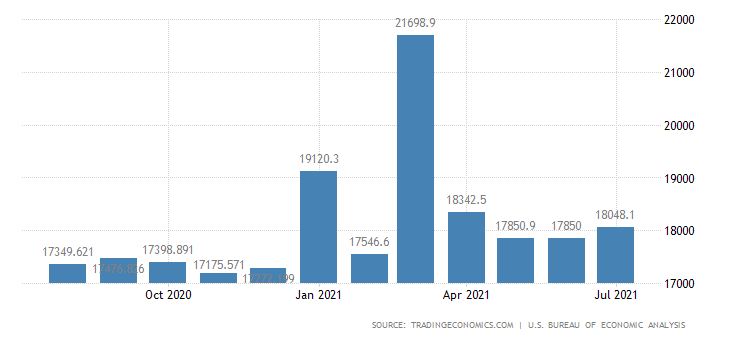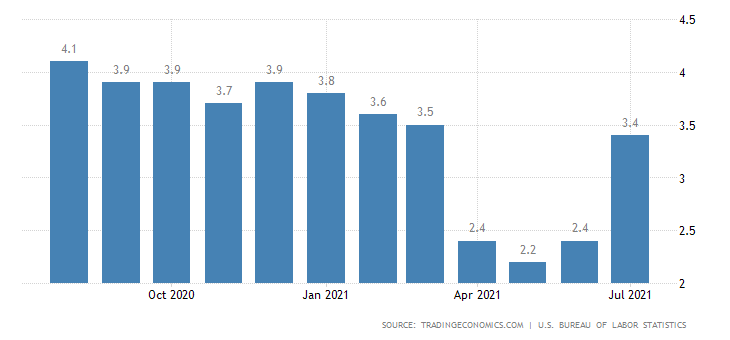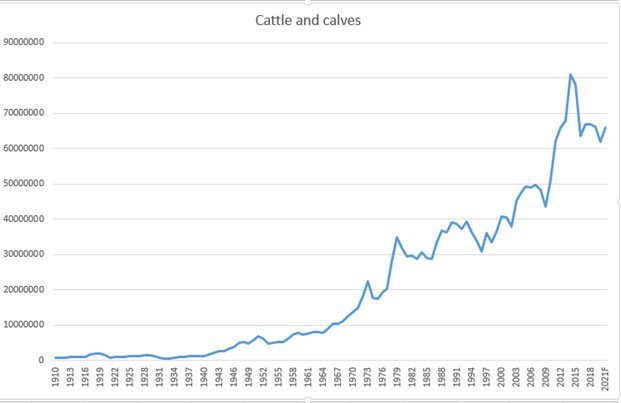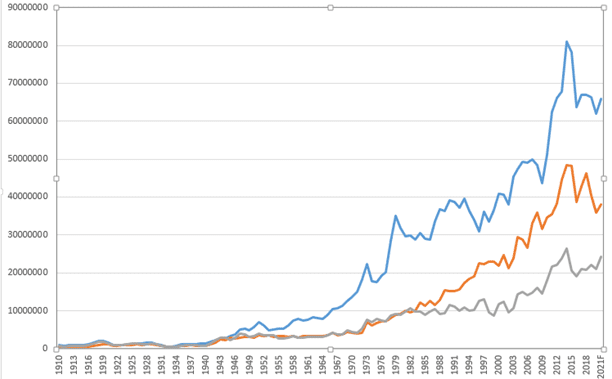Labeling for Increased Profits, Farmer and Economist, Michael Smith It is a well-known marketing ploy to label, relabel, and even mislabel a product again and again to increase sales. We think of the almighty Coke and the multiple iterations that they have had just on their cans. We’ve also seen consumer products like paper towels that have additives that make a mess disappear much faster, diapers that hold, ahem, waste better, and other innovations of consumer products that make our today better than the yesterday. So how is a product marketed as different, when it could or could not be much different than say, a thousand years ago? Disposable income in the country has exploded in the past 25 years as evidenced here: United States
Topics:
run75441 considers the following as important: agricultural economics, agriculture, Education, Featured Stories, food, Hot Topics, Michael Smith, US/Global Economics
This could be interesting, too:
NewDealdemocrat writes JOLTS revisions from Yesterday’s Report
Joel Eissenberg writes No Invading Allies Act
Ken Melvin writes A Developed Taste
Joel Eissenberg writes How Tesla makes money
Labeling for Increased Profits, Farmer and Economist, Michael Smith
It is a well-known marketing ploy to label, relabel, and even mislabel a product again and again to increase sales. We think of the almighty Coke and the multiple iterations that they have had just on their cans. We’ve also seen consumer products like paper towels that have additives that make a mess disappear much faster, diapers that hold, ahem, waste better, and other innovations of consumer products that make our today better than the yesterday.
So how is a product marketed as different, when it could or could not be much different than say, a thousand years ago?
Disposable income in the country has exploded in the past 25 years as evidenced here:

Mean household disposable income is now, depending upon poll and date, anywhere from $76,057 per year upwards to $91,000 a year for the standard white family of four. Sadly, we have not seen the same in the minority communities and have to discount disposable income for those groups to 61 cents per every dollar of the above stated ($46,394 if we do the math).
As the suburban disposable incomes have risen, so have also consumer staples, as evidenced by the Consumer Price Index (CPI) over that same period:

The two trends of higher disposable income are directly correlated to the increase of CPI over that same period. But what about food prices? Well, here is the same period with data from the BLS:

Now we see a non-conforming set of data in our statistics. I will leave this statistical anomaly up to the finer professionals that write here regularly.
Who are the marketing campaigns for?
As cost of living has increased since the 1980s, so has disposable income, however there is a breakdown as white middle and upper class Americans now command a higher percentage. This allows them to shell out 10% more on average for a Tesla, buy groceries exclusively from Whole Foods, and also pay for labels.
Remember a time of “the Incredible Edible Egg!” or “Pork, the Other White Meat”, or even, “Beef, its what’s for dinner” Those were similar times.
Trade industries for years have thrown money at ad campaigns, and yet recently have stopped. One reason we can explain this is the beef production per year going back to 1910:
We can correlate by this data that beef consumption largely mirrors population growth, as with most things in consumer consumption. We can also have a look at the spikes in certain areas. Let’s start by smoothing it out. Let’s assume consumer consumption since 1985 has not changed, and that the consumption of meat be it beef, poultry, or pork, is somewhat interchangeable. Fungible goods.
In this graph, we have the beef (blue), poultry (orange), and pork (grey).
What we can extrapolate is that the good are fungible to a point, where the increase in poultry in 1995-1996 did drive a decrease in both pork and beef. So what was going on in marketing in 1995? This year came on the heels of the largest E.coli scare in 1992 where Jack in The Box had contaminated products – beef. That could be one reason for the inversion. Another could be the holdover from the 70-80s anti-fat movements that culminated in a demonization of anything but poultry and turkey, until, in the mid-90s “The Other White Meat” campaign started and pork was lumped into poultry and turkey, although loosely by a New York Times article that was repeated for years until pork loin became interchangeable with poultry and beef in the bin of White Meat. We can also see drives of this around the turn of the century in sports drinks, which to find out, were mostly sugar water with a bit of salt, all made by Pepsi Co, and Coca-Cola, to increase market share. Now that the sugar movement has taken a hit, Pepsi Co. Coca-Cola, and Nestle have double down on water and run campaigns so that the general public doesn’t realize that the municipal supplies their tax dollars pay for are the same taps that fill the plastic bottles they spend over $1 for.
What can we infer? Marketing matters.
The sugar industry demonized high fat diets as American’s pant size increased year after year. Now that pendulum has swung the other way. But as of the early 2000s a new movement as become common place: organics. Organics is the process of producing crop and also meat off of minimally treated, somewhat non-invasive methods. We grow produce using responsible methods, and then feed that to the animals and we eat both. The birth of the Organic movement was well on its way in 2005, with a Certification from the USDA program established in 1990, which had arguably lived in obscurity until then
Fast forward a few years with further demonization of the meat industry due to documentary films such as Food, Inc. and Forks Over Knives! One wants you to buy from a farmer, one wants you to stop buying meat altogether. The birth of Veganism.
What’s in a label?
Let’s break down public perception into actual quantitative reality:
Level 1 – “All Natural”, “Clean”, “No Hormones or Antibiotics”
Public perception – “They are pumping these plants and animals with all kinds of chemicals”
Reality –The process has not changed in 60 years. Antibiotics are expensive, as are chemicals.
Level 2 – “Third Party Certified”
Public perception – interchangeable with USDA Certified Organic
Reality – I pay these guys for a label for my packaging. They may or may not certify anything
Level 3 – USDA Certified Organic
Public perception – “superior quality over the terrible agriculture models”
Reality?
I pay the USDA $10,000 for them to audit my practices and if they do not conform, I can’t use the labeling. Meaning, if I use a product that is ethically, or environmentally better than their guidance I cannot sell as certified organic.
These are the three most commonplace labeling/marketing schema out there right now, but there are two new ones on the horizon about to take the market:
Newspeak 1 & 2
1 – “Certified Regenerative”
Public perception – “They are capturing carbon and regenerating the soils to help with climate change.”
Reality – Pastured meat production has always done this. Most vegetable farms that are multi-generational have been doing this. This is also known as Grandpa’s method and has been around since the European settlers threw dead fish in the ground to plant corn as per instructed by the Iroquois.
2 – “Certified Vegan”
Public perception – “You mean this whole time they have been using animal byproducts to grow our organic vegetables?”
Reality?
Yes. We use bone meal, blood meal, fish emulsion, manure, and whatever organic materials we can get our hands on. The majority of the organics we are collecting to compost and fertilize are almost 100% waste products from the fishing, meat processing, and animal raising process. We also get compost from mushroom farms as well, which cannot reuse their compost. If we were to switch to an engineered lab produced set of fertilizers we would have 3x the costs as well as 3x the waste. Chemical waste, I don’t need to explain, we have billions tied up in superfund sites.
We know marketing works. With disposable incomes increasing over time and now a 600% jump in people who identify as alternative consumers (vegan, vegetarian) we now have 9.6 million people with an abundance of funds to dramatically sway the vanity market, for better or worse. We need to be informed as to what these labels mean for the end consumer, as well as the farmer. The middle man will always get his gold.


